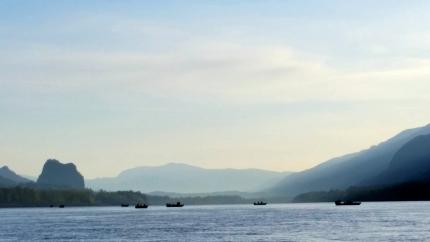
The Columbia River, one of the largest rivers in North America, has tremendous economic importance in the forms of hydropower and clean energy, transportation, and irrigation, and is a critical waterway for salmon, steelhead, and a multitude of other aquatic species. The fishery, meanwhile, has its own economic importance, with recreational, commercial, and tribal fishing delivering a much-needed boost to local communities and other interests statewide.
The Columbia River basin stretches across a huge portion of Washington state, from the Pacific Ocean to the Canada, Oregon, and Idaho borders. Dozens of different salmon and steelhead runs migrate in and out of the river and its tributaries every year, many traveling hundreds of miles as they move between their home spawning grounds and the ocean. Those runs include several listed as threatened or endangered under the Endangered Species Act (ESA), such as Snake River steelhead, lower Columbia River Chinook, and Snake River sockeye.
Find information and resources
WDFW is tasked with managing the fish and wildlife resources along the river for conservation and recreation, in partnership with other states, federal entities, and tribal co-managers.
Columbia River videos
Learn more about managing Columbia River fisheries in our video series:
-
Columbia River joint-state management
Columbia River non-treaty fisheries are managed cooperatively by Oregon and Washington in shared waters, which includes the Columbia River Compact.
-
Recreational fishing
Learn about regulations and areas for recreational fishing on the Columbia River.
-
Commercial fishing
Information about commercial fishing and commercial gear types on the Columbia River.
-
Alternative gear
WDFW is working to further develop and implement alternative commercial gears on the Columbia River.
-
Cowlitz River smelt
The southern distinct population segment of eulachon, commonly referred to as "Columbia River smelt," supports a popular recreational fishery.
-
Pikeminnow Sport-Reward Fishery Program
Northern pikeminnow eat millions of salmon and steelhead juveniles each year in the Columbia and Snake River systems.
-
Columbia River license reduction program
WDFW is working to implement a voluntary buy-back of commercial fishing licenses on the Columbia River.
-
Research and monitoring
Learn about the tools, techniques, and methodologies WDFW uses to collect and analyze data from fisheries.
-
SW Washington fishing reports
Fishing reports and other information for waters in southwest Washington, including the Columbia River and its tributaries.
-
Columbia River white sturgeon
Information about white sturgeon fisheries and quotas on the Columbia River.
-
Columbia River hydropower system
There are numerous dams throughout the Columbia River basin that have impacts on fish and wildlife species, including ESA-listed salmon and steelhead.